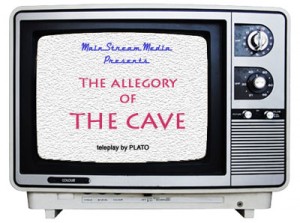| Online: | |
| Visits: | |
| Stories: |

| Story Views | |
| Now: | |
| Last Hour: | |
| Last 24 Hours: | |
| Total: | |
Institutional Thinking – The Matrix, 1984 and The Allegory of The Cave
Contributing Writer for Wake Up World
Some philosophical work is so profound as to be influential for thousands of years. Plato’s ‘The Republic‘ is one such series of dialogues. It explains and explores the relationship between state institutions and individuals, and has provided humanity with lessons in politics, philosophy and individual enlightenment since it was penned some two thousand years ago.
One of the central dialogues in The Republic is called the Allegory of the Cave. The lessons the Allegory of the Cave provides to today’s world are numerous, and its depiction of our insidious societal structure is extremely accurate and insightful — despite often going unacknowledged as such. Through its exploration of our political outer states, it also explores our psychological inner state as well.

The Allegory of The Cave proposes that what people take to be ‘reality’ in total is only a partial reality, or an all out illusion. As is all similar philosophy, the allegory is layered, but it is partially about breaking from mainstream thinking and seeking individual knowledge; the ascension of perspective; being in a cave and coming out of a cave. It’s about how we can ascend from the bottom to stand face-to-face with the golden Sun.
Socrates begins: “Let me show you in a figure how far our nature is enlightened or unenlightened Behold! Human beings living in an underground cave”.
The 4 Characters of the Cave
In the Allegory there are four character types. Most people are chained, forced to watch images on a cave wall. Some however, the second character type, are unchained. They need no force; they are so transfixed with the imagery on the wall that the shadows are all they care about, and remain in the cave by choice. The images are cast on the wall by the third character type, the captors, who use a fire behind them to produce various shadows, to keep the prisoners entertained. The prisoners interpret the shadows and whatever noises are made as reality in total, for it is all they know. The fourth character type is the freed prisoner.
The narrative of The Cave hypothesizes what happens after the prisoner is released from the false imagery to which his society is subjected. In the film The Matrix, Neo is the freed prisoner; in 1984, Winston Smith dreams of being the freed prisoner.
The Freed Prisoner
The story of the freed prisoner goes that, after initial shock and distress, the prisoner learns to distinguish between reality and shadows, and sees the fire producing the shadows. When exiting the cave, he is first blinded by the light but eventually learns the basics of nature. He learns what is real, and what is shadow and reflection. He learns of Earth and Water and that all is dependent on the Sun, seasons and all life. After learning of the true reality outside the cave, free of the false images of his captors, the prisoner is inclined to return and inform those still confined to the cave of their present predicament… with unexpected results.
Similarly, the story of 1984 by George Orwell takes place within an imagined dystopian future; the allegorical cavern. The Telescreen, which constantly transmits as well as oversees, is equivalent to the shadows on the cave wall cast by the unseen captors, the Inner Party. Most people in 1984 are Proles; they are equivalent to the people chained in the cave, forced to accept false imagery as their reality. They have been prisoners their whole lives and do not notice the fact they are chained. The Outer party are the unchained, remaining totally transfixed on the party line told by the Telescreen. They are so loyal to the imagery and narrative created by their captors that they will believe whatever they are shown, rather than observe for themselves. They will believe two plus two is five, as the saying goes, as long as it is presented as such on the Telescreen.
In the dystopian world of The Matrix, the same futuristic Allegory of The Cave is again explored. Neo is freed and seeks to free the others, and encounters the same archetypes and challenges.
Moreover the return of the freed prisoner can also be related to the ‘return of the prophet’ described in many theological constructs.
The Freed and the Scorned
Previous articles by Ethan:
- The Great Unsaid: What 1984 Can Teach Us About 2014
- Institutional Thinking: Understanding the Mental and National States of War
- A Little Green Revolution: the Rainbow Warriors will Heal the Earth Mother
- Saṃsāra and Nirvana – the Ultimate Duality
- We Have Sustainable Energy Technology – the Problem is the Oligarchy
- Why Governments Promote Deadly Nuclear Energy and Ban Beneficial Hemp
- The Brotherhood of Man: a Tibetan Perspective
- The 5 Tibetan Rites of Rejuvenation: 108 Movements to a Meditative Mind State
- How to Enhance Intuition: Understanding the Four Forms of Awareness
- Hate: The Ultimate Social Control Mechanism
- UK’s Proposed Ban on Esoteric Knowledge: Why Institutions Seek to Limit Access to Information
- Presence and Mindfulness: the Meditative Value of 108
- Is Nuclear Experimentation Fascism?
- Oligarchical Collectivism and the Four Steps to Learning Politics
- Meditation and Intuition in the Fourth Age of Deception (the Kali Yuga)
Follow Wake Up World On…
[FACEBOOK]: http://www.facebook.com/joinwakeupworld
[PINTEREST]: http://pinterest.com/wakeupword/
[TWITTER]: http://twitter.com/joinwakeupworld
[YOUTUBE]: http://www.youtube.com/joinwakeupworld
[GOOGLE PLUS]: https://plus.google.com/112452105795129310867/posts
[WEBSITE]: http://wakeup-world.com




